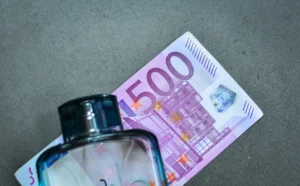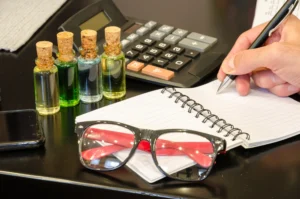Numbers remain the true language of success—especially in vital sectors like the perfume industry. But have you ever considered how profitable this field really is and how it could generate returns beyond your expectations?
Today, Jasmine takes you through the perfume profit margin: their average across different markets, the key factors that influence them, and the best strategies to boost them in 2025.
Perfume business profit margin & How to Calculate
The profit margin in the perfume business refers to the percentage of profit you earn from selling a fragrance after subtracting the product’s cost. This margin reflects how efficiently your venture turns costs into profits and serves as a key indicator of its economic viability.
To calculate it, subtract the product cost from the selling price, divide the result by the selling price, then multiply by 100 to get the percentage.
Average Profit Margin in the Perfume Trade
Of course, this margin isn’t fixed or uniform—it varies based on several factors. But before we dive into what influences it, let’s take a look at its average in a few different scenarios:
Average Profit Margin in Arab Markets
The perfume sector in Arab markets is known for its attractive profit margins, with estimates suggesting that profit rates can range from 50% to 90% of the selling price.
This range reflects the strong demand for fragrances in the region and is shaped by factors such as raw material costs, production or import processes, and the marketing strategies in place.
Profit Margins for Original Perfumes and Global Brands
That’s considered a healthy profit margin—especially when compared to general market products, where gross profits typically range between 50% and 70%, while specialized or luxury brands can reach margins of 70% to 85%. This is largely due to perceived brand value, substantial marketing expenses, and distribution dynamics. Whether you’re a distributor or a wholesaler, you can expect margins ranging from 3% to 60% of the selling price, depending on how involved you are in marketing and distribution.
Profit Margins in Blended or Traditional Perfume Trade
Estimates show that perfume stores focusing on customized or exclusive offerings tend to achieve profit margins ranging from 20% to 35%, reaching up to 40% with high-end fragrances. This reflects the relatively low cost of raw materials and the ability to offer unique products at competitive prices.
ِAlso read: How to Conduct Perfume Business Feasibility Study 2025?

Factors Influencing Perfume Trade Profit Margins
Setting profit margins in the perfume business isn’t just about the selling price—it’s shaped by several essential factors. Here are the most critical ones:
Cost of Raw Materials and Manufacturing
The quality and type of fragrance ingredients, along with blending or production costs, all contribute to the total cost of a perfume. The more competitively you source your materials, the higher your potential profit margin.
Pricing Strategy
Setting the final retail price is a crucial decision that requires a careful balance—attracting customers while covering costs and generating healthy returns. Overpricing can slow sales, while underpricing can shrink profits.
Marketing and Promotion Costs
Advertising campaigns, digital marketing, and trade show participation consume part of your budget. Smart investments in effective marketing increase brand awareness and drive sales—ultimately boosting your bottom line.
Sales and Distribution Channels
Whether you sell through a physical store, online platform, or third-party distributors, each channel comes with its own cost structure. Choosing the most cost-effective and customer-accessible channels directly impacts your net profit.
Sales Volume and Inventory Turnover
Selling higher volumes allows you to spread fixed costs over more units, increasing profit per item. Efficient inventory management and avoiding overstock reduce potential losses and improve profitability.
Ready to start your perfume business with confidence? Contact our team at Jasmine—we’ll help you analyze the market and define these factors to maximize your profit margins.
Also read: Perfume Business: Is selling Perfume Profitable?

How to Increase Your Perfume Business Profit Margins
At Jasmine, we’ll share proven, effective methods to boost your perfume sales profit margins while ensuring your business’s sustainability and growth.
Optimize Pricing Strategies
By analyzing competitors’ prices and your product’s perceived value, you can set an ideal price. Consider psychological pricing or offering bundles and promotions to increase purchase appeal without significantly lowering value.
Focus on Quality at Competitive Prices
Find suppliers who provide high-quality oils and raw materials at reasonable costs. Quality attracts loyal customers, while good pricing increases the profit margin per unit.
Develop Diverse Sales Channels
Don’t rely on just one sales channel—launch an online store, participate in trade shows, and collaborate with influencers. Diversifying channels expands your customer reach and lowers marketing costs per new client.
Effective Marketing and Brand Building
A strong brand story and creative marketing make your perfume more appealing and valuable to consumers. This allows you to justify higher prices and reduces the need for price competition.
Reduce Unnecessary Operating Costs
Regularly review all expenses and look for ways to cut costs without compromising product or service quality. This can include negotiating with suppliers or improving inventory management to minimize waste.
Applying these strategies wisely can make a significant difference in your project’s profitability. So, get in touch with Jasmine, let us be your partner in your perfume venture, and watch your profit margins grow.
Also read: Best Strategies to Sell Perfumes in the Markets for 2025

Jasmine: The Best Manufacturer for Wholesale Perfumes and Fragrances
When searching for a trusted partner in the world of perfumes and fragrances, you need someone who combines high quality with competitive prices. Jasmine offers the perfect solution to confidently start or grow your business.
Why is Jasmine your ideal partner for wholesale perfumes and fragrances?
- Jasmine provides a wide range of perfumes and fragrances to suit diverse tastes and customer preferences.
- We are committed to delivering high-quality products made from the finest raw materials sourced from reliable global suppliers.
- Our role goes beyond just supply—we offer technical support and expert consultations to assist you at every stage of your project.
- Understanding the importance of good profit margins, we offer our products at highly competitive prices.
- We guarantee a seamless and comprehensive logistics process, from order preparation to fast and secure shipping.
- We see ourselves as a true partner in your business success, not just a supplier. We provide ongoing support and technical advice to help you overcome challenges.
To turn your ambitions in the perfume and fragrance industry into reality, Jasmine is your best choice. Visit our website now, and let us be part of your success story.
Also read: How to Choose the Right Wholesale Perfume Supplier? Full Guide for Store Owners
FAQs About Perfume Profit Margin
What is the profit margin in perfumes?
Profit margins in perfumes typically range from 50% to 90% of the selling price and can be higher for blended or locally manufactured fragrances. This depends on factors like raw material costs and the product’s final marketing.
How profitable is the perfume trade?
The perfume business is highly profitable, with profit margins sometimes reaching 100% or more, especially for blended perfumes or those with low raw material costs. Margins vary based on product quality and pricing, but you can generally expect to earn between 20% and 60% of your revenue as profit.
What profits do perfume companies make?
Perfume companies earn substantial profits; global luxury brands can achieve gross margins of 70% to 85%. Major companies in the Middle East have reported profit margins exceeding 60% in certain years.
How can you become a successful perfume seller?
To succeed as a perfume seller, focus on building a distinctive brand identity and telling a story behind each fragrance. Prioritize quality and offer a unique shopping experience through sensory marketing and continuous customer engagement to foster loyalty
.